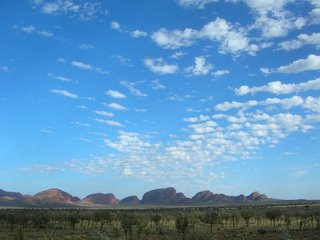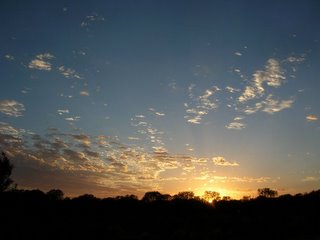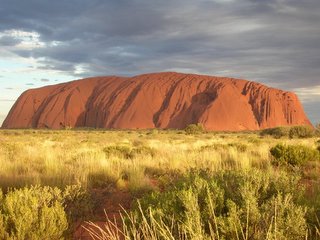"Avagoyermug!"
G’day! This Christmas we were in the Northern Territories of Australia.
Before I continue, I should explain a couple of things. As with so many things in life these days, one has to be sensitive in the way one labels people. I'll be writing about Australian Aborigines and other Australians, so I need to explain the terms I'll be using. Apparently, using “Aboriginals” as a noun is offensive, as is “Abo”, although using "Aboriginal" as an adjective is fine. The politically correct terms are “indigenous Australian” or “Australian Aborigine”. Rather a mouthful, but, because offending people is the last thing I want to do, and because it seems that any abbreviation these days is offensive or insensitive (so don't go calling me a Brit), I’ll copy and paste the “AA” term above.
Similarly, what do I call “Australians”, as in the (mainly) white Australians that were sent over on convict ships for stealing lettuces?
Aussies, of course.
Anyway, we hired a camper-van as soon as we arrived in Darwin and headed South, driving all the way to Ayers Rock (or Uluru as it’s known by Australian Aborigines) and back in a 10 day “road-trip”.
We saw some incredible wildlife and landscape and met some interesting people, too. Indeed, the Aussies we met seemed keen to chat and practice their English on us. It was lucky, then, that our Lonely Planet actually had an Australian-English dictionary in the back. It included useful phrases such as “how are ya?” and “g’day” which I would have really struggled to define without Lonely Planet’s help.
Most of the Australians we spoke to were quite helpful, I noticed, in their use of language. They would, for example, mention something called a “croc”, then, helpfully, straightaway afterwards, would look in our direction and say, “that’s a crocodile to you Poms”.
We managed to do about 6000km in our 10 days on the road. We didn’t start off intending to do that, but on our first day we drove down to Katherine, famous for its Gorge, and got out of the van to have a walk. After two hours we were dripping with sweat and thoroughly miserable. Most of our energy had been expended trying to beat flies off, as it were. The flies were a problem everywhere and they seemed particularly attracted to my eyes, which was not particularly pleasant. As it was the middle of the wet season, the humidity made steep walking unbearable at midday. With these factors combined, we decided that, rather than seeing the country by walking around in the heat of the day, we would do better by driving through it in an air-conditioned van and aimed to get down to the less humid centre of Australia as quickly as possible. We then tended to do most of our walking at sunrise or sunset, which was far more bearable (and sensible).
We also bought some flynets. Although they made us feel stupid, look stupid and feel like tourists, they enabled us to conserve some of that energy.
So, we set off on our road-trip, hoping to be at Uluru/Ayers Rock by Christmas. According to the publicity information, it's the biggest monolith on planet earth. When we arrived ahead of schedule, by sunset on the 23rd December, we weren't disappointed. As I'm sure you know, sunrises and sunsets are meant to be special times to see Uluru/Ayers Rock, because of the way the rock changes colour. This first evening was when we saw it at its best, actually. Swathed in cloud and bathed in fading sunlight, it was an awe-inspiring sight. Monolithic!
About 40km down the road, visible from certain points around Uluru/Ayers Rock, lies another rock formation, which is called The Olgas/Kata Tjuta. Although this one isn't a monolith, we agreed that it was actually even more impressive than Uluru/Ayers Rock. We asked an Aussie about this, and asked him why it was that everyone's heard of Ayers Rock whereas comparatively few people had heard of The Olgas. He replied, "Ayers Rock? It's the rock!" which really cleared it up for us.
Anyway, it's a fascinating place, shrouded in mystery, slap-bang in the middle of nowhere. Technically, it's owned by the local Australian Aborigines, although they've leased it back to the Aussie government for 99 years. Despite the fact that this rock is "owned" and looked after from within the boundaries of a National Park, they seem a bit tentative about issuing instructions. For example, there is a handrail on the rock which goes up the first 30 metres or so. This would seem to imply that it's ok to climb the rock. Why not, after all? We climb mountains and hills around the world. Apparently, though, it upsets the Australian Aborigines who own the rock, and the Aussies they've leased it to, because, if you fall off and die, they feel responsible. This is fine, of course. My advice, then, would be to remove the handrail and fine anyone who tries to climb it, rather than being all namby-pamby about it. I only mention this because Aussies are renowned for calling a spade a spade - indeed, on our way down we'd seen street signs saying things like "DON'T BLOODY OVERTAKE!" - so it seemed odd that here, at the classic Australian icon, they were behaving like Hugh Grant: "Er... excuse me... if you don't mind, awfully... do you mind taking your foot off the rock? You do mind? Oh well, never mind... sorry.... as you were..."
We spent a couple of days there, walking around both rocks and learning some stuff about the culture of the Australian Aborigine. We saw two sunrises and two sunsets before heading back North on the long journey back to Darwin. On Christmas morning, before we set off, we watched the sun rising behind the rock, and, as it peeked over the top, I asked Ella to marry me. She said yes, too. It was all very romantic.
Typical me, though, I was being harrassed by flies that morning, so I was wearing the ubiquitous flynet.
Here are some photos. They say a lot more than the silly words I tend to write. I am in the process of writing some more stuff about the trip, so watch this space.
Before I continue, I should explain a couple of things. As with so many things in life these days, one has to be sensitive in the way one labels people. I'll be writing about Australian Aborigines and other Australians, so I need to explain the terms I'll be using. Apparently, using “Aboriginals” as a noun is offensive, as is “Abo”, although using "Aboriginal" as an adjective is fine. The politically correct terms are “indigenous Australian” or “Australian Aborigine”. Rather a mouthful, but, because offending people is the last thing I want to do, and because it seems that any abbreviation these days is offensive or insensitive (so don't go calling me a Brit), I’ll copy and paste the “AA” term above.
Similarly, what do I call “Australians”, as in the (mainly) white Australians that were sent over on convict ships for stealing lettuces?
Aussies, of course.
Anyway, we hired a camper-van as soon as we arrived in Darwin and headed South, driving all the way to Ayers Rock (or Uluru as it’s known by Australian Aborigines) and back in a 10 day “road-trip”.
We saw some incredible wildlife and landscape and met some interesting people, too. Indeed, the Aussies we met seemed keen to chat and practice their English on us. It was lucky, then, that our Lonely Planet actually had an Australian-English dictionary in the back. It included useful phrases such as “how are ya?” and “g’day” which I would have really struggled to define without Lonely Planet’s help.
Most of the Australians we spoke to were quite helpful, I noticed, in their use of language. They would, for example, mention something called a “croc”, then, helpfully, straightaway afterwards, would look in our direction and say, “that’s a crocodile to you Poms”.
We managed to do about 6000km in our 10 days on the road. We didn’t start off intending to do that, but on our first day we drove down to Katherine, famous for its Gorge, and got out of the van to have a walk. After two hours we were dripping with sweat and thoroughly miserable. Most of our energy had been expended trying to beat flies off, as it were. The flies were a problem everywhere and they seemed particularly attracted to my eyes, which was not particularly pleasant. As it was the middle of the wet season, the humidity made steep walking unbearable at midday. With these factors combined, we decided that, rather than seeing the country by walking around in the heat of the day, we would do better by driving through it in an air-conditioned van and aimed to get down to the less humid centre of Australia as quickly as possible. We then tended to do most of our walking at sunrise or sunset, which was far more bearable (and sensible).
We also bought some flynets. Although they made us feel stupid, look stupid and feel like tourists, they enabled us to conserve some of that energy.
So, we set off on our road-trip, hoping to be at Uluru/Ayers Rock by Christmas. According to the publicity information, it's the biggest monolith on planet earth. When we arrived ahead of schedule, by sunset on the 23rd December, we weren't disappointed. As I'm sure you know, sunrises and sunsets are meant to be special times to see Uluru/Ayers Rock, because of the way the rock changes colour. This first evening was when we saw it at its best, actually. Swathed in cloud and bathed in fading sunlight, it was an awe-inspiring sight. Monolithic!
About 40km down the road, visible from certain points around Uluru/Ayers Rock, lies another rock formation, which is called The Olgas/Kata Tjuta. Although this one isn't a monolith, we agreed that it was actually even more impressive than Uluru/Ayers Rock. We asked an Aussie about this, and asked him why it was that everyone's heard of Ayers Rock whereas comparatively few people had heard of The Olgas. He replied, "Ayers Rock? It's the rock!" which really cleared it up for us.
Anyway, it's a fascinating place, shrouded in mystery, slap-bang in the middle of nowhere. Technically, it's owned by the local Australian Aborigines, although they've leased it back to the Aussie government for 99 years. Despite the fact that this rock is "owned" and looked after from within the boundaries of a National Park, they seem a bit tentative about issuing instructions. For example, there is a handrail on the rock which goes up the first 30 metres or so. This would seem to imply that it's ok to climb the rock. Why not, after all? We climb mountains and hills around the world. Apparently, though, it upsets the Australian Aborigines who own the rock, and the Aussies they've leased it to, because, if you fall off and die, they feel responsible. This is fine, of course. My advice, then, would be to remove the handrail and fine anyone who tries to climb it, rather than being all namby-pamby about it. I only mention this because Aussies are renowned for calling a spade a spade - indeed, on our way down we'd seen street signs saying things like "DON'T BLOODY OVERTAKE!" - so it seemed odd that here, at the classic Australian icon, they were behaving like Hugh Grant: "Er... excuse me... if you don't mind, awfully... do you mind taking your foot off the rock? You do mind? Oh well, never mind... sorry.... as you were..."
We spent a couple of days there, walking around both rocks and learning some stuff about the culture of the Australian Aborigine. We saw two sunrises and two sunsets before heading back North on the long journey back to Darwin. On Christmas morning, before we set off, we watched the sun rising behind the rock, and, as it peeked over the top, I asked Ella to marry me. She said yes, too. It was all very romantic.
Typical me, though, I was being harrassed by flies that morning, so I was wearing the ubiquitous flynet.
Here are some photos. They say a lot more than the silly words I tend to write. I am in the process of writing some more stuff about the trip, so watch this space.









